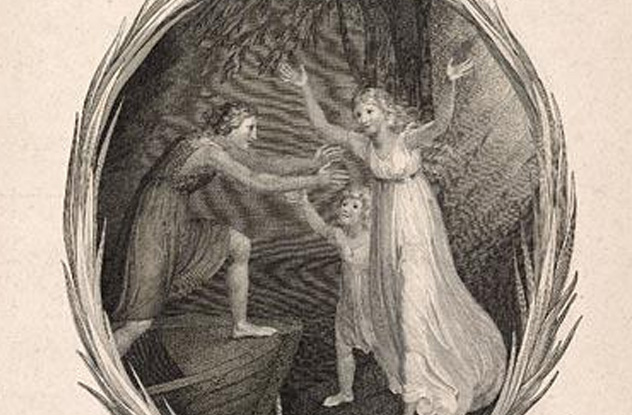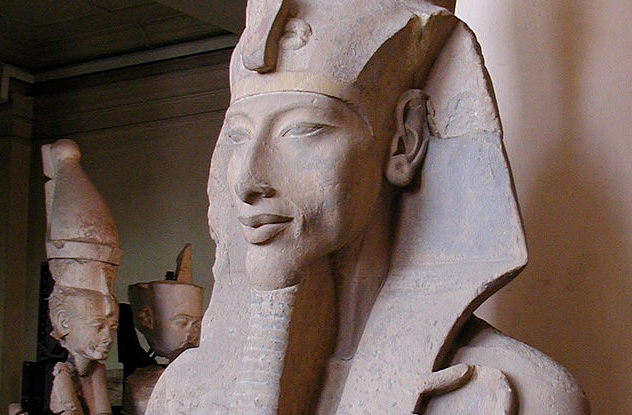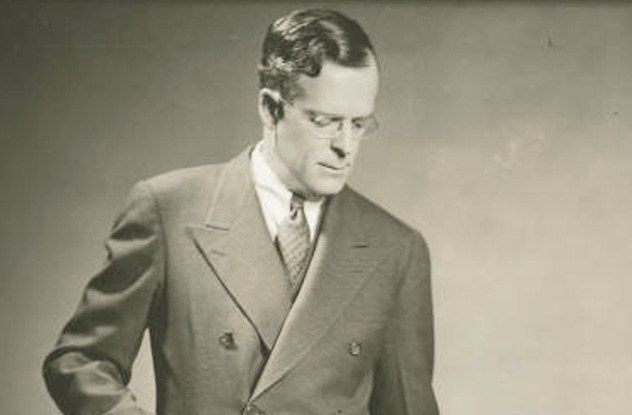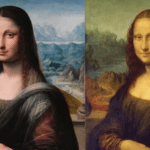 Movies and TV
Movies and TV  Movies and TV
Movies and TV  Weird Stuff
Weird Stuff 10 Times Real Laws Were Based on Bizarre Hypotheticals
 Animals
Animals 10 Inspiring Tales of Horses Being Human
 Mysteries
Mysteries Top 10 Haunting Facts About the Ghost Ship MV Alta
 History
History 10 Surprising Stories About the Texas Rangers
 Humans
Humans 10 Philosophers Who Were Driven Mad by Their Own Theories
 Miscellaneous
Miscellaneous 10 Video-Game-Worthy Weapons and Armors from History
 Weird Stuff
Weird Stuff 10 Psychics Who Accurately Predicted Wartime Events
 The Arts
The Arts 10 Pieces of Art Inspired by a Broken Heart
 Health
Health 10 Science Fiction-Sounding New Medical Treatments
 Movies and TV
Movies and TV 10 Movies That Get Elite Jobs Right, According to Experts
 Weird Stuff
Weird Stuff 10 Times Real Laws Were Based on Bizarre Hypotheticals
 Animals
Animals 10 Inspiring Tales of Horses Being Human
Who's Behind Listverse?

Jamie Frater
Head Editor
Jamie founded Listverse due to an insatiable desire to share fascinating, obscure, and bizarre facts. He has been a guest speaker on numerous national radio and television stations and is a five time published author.
More About Us Mysteries
Mysteries Top 10 Haunting Facts About the Ghost Ship MV Alta
 History
History 10 Surprising Stories About the Texas Rangers
 Humans
Humans 10 Philosophers Who Were Driven Mad by Their Own Theories
 Miscellaneous
Miscellaneous 10 Video-Game-Worthy Weapons and Armors from History
 Weird Stuff
Weird Stuff 10 Psychics Who Accurately Predicted Wartime Events
 The Arts
The Arts 10 Pieces of Art Inspired by a Broken Heart
 Health
Health 10 Science Fiction-Sounding New Medical Treatments
10 Trailblazers Overshadowed By Their Famous Spouses
We typically use the expression “better half” as a simple term of endearment for our partners. However, there are cases when the expression is very apt—cases where one member of the couple was clearly the overachiever. This isn’t necessarily a slight against their partners, though. They were successful in their own right. Their only fault was falling in love with their true better halves.
10Constance Wilde

Constance Mary Lloyd was born on January 2, 1859, in Dublin. In 1884, she married famed playwright Oscar Wilde, and the two of them became a celebrity couple, a 19th-century Irish Brangelina. “Mrs. Oscar,” as she was referred to in the papers, became an activist who argued for women’s rights to serve in parliament. This alone was enough to earn her the scorn of traditionalists, but Constance went even further when she involved herself in the Rational Dress Society. The group advocated that women wear comfortable, practical clothing instead of the corsets and other tight clothing customary for Victorian women.
Her marriage to Oscar Wilde appeared to go smoothly at first. The couple had two children in their first years. It’s hard to tell when Wilde decided he preferred the company of young men, but by the time of his relationship with Lord Alfred Douglas in the early 1890s, his affairs became an open secret.
Although Oscar Wilde was clearly the writer in the family, Constance had her own share of success with a book of children’s stories titled There Was Once. Whether or not she knew of her husband’s affairs beforehand is impossible to tell, but she certainly found out in 1895 when Oscar Wilde was imprisoned for homosexuality. She then changed her name to “Holland” and moved to Italy, where she died of mysterious circumstances aged 39. It wasn’t until recently that family letters suggested undiagnosed multiple sclerosis as her cause of death.
9Anne Hunter

Anne Hunter was an 18th-century poet, although she achieved her greatest success as a lyricist. Even so, Anne remained in the shadow of her husband, John Hunter, for most of her life. He was one of the most distinguished surgeons of all time. A fellow of the Royal Society, Hunter was an early proponent of the scientific method in medicine. He dedicated the latter half of his career to teaching and also established a medical museum containing over 14,000 specimens from 500 different species of plants and animals. The Hunterian Museum (which still exists today) contained many exotic species brought to Hunter from all over the world, such as kangaroos from James Cook’s trip to Australia.
Anne’s career took a backseat to her family life. After first experiencing success in 1765 when her first songbooks were published, Anne took a break once she married Hunter in 1771. After his death in 1793, Anne resumed her career thanks to a collaboration with famed composer Joseph Haydn. She wrote lyrics to many of his compositions in English, prompting rumors that she was either Haydn’s muse or his secret lover.
8Pierre Curie

Although Pierre Curie’s name resonates within the scientific community, there’s no doubt that his wife’s name resonates more. Together, Pierre and Marie Curie won the 1903’s Nobel Prize in Physics for their work on radioactivity (a prize they shared with Henri Becquerel). However, Marie Curie reached this milestone again in 1911 with a Nobel Prize in Chemistry. In the process, she also became the first person and the only woman to win two Nobel Prizes, as well as the only person to win in two different categories. This tradition was continued by the Curies’ daughter Irene, who won a Nobel Prize of her own in 1935.
The Curie legacy actually started with Pierre and his brother Paul-Jacques. The two of them studied together as teenagers, focusing their attention on crystallography. Their combined efforts culminated in the discovery of piezoelectricity in 1880. This eventually earned Pierre a teaching position at the University of Paris, where he would meet Maria Sklodowska, soon to be Marie Curie.
Maria initially refused his advances, as she was planning to return to her native Poland and teach at Warsaw University. Unfortunately for her (but fortunately for the world), the university refused to hire her because she was a woman. So she returned to Paris and became Marie Curie. The rest is history. Perhaps Pierre would be just as renowned as his wife is today were it not for his sudden death in 1906 (28 years before Marie) in a traffic accident.
7Joy Davidman

American writer Helen Joy Davidman began a very promising career as a child prodigy and was already receiving awards for her first book of poetry, Letter to a Comrade, in her early twenties. Her first marriage was with fellow writer William Lindsay Gresham, but that would only mark a long and unhappy chapter in her life.
During her troubled marriage, Davidman turned to the religious writings of C.S. Lewis. In fact, she found them so inspirational that they prompted a conversion from atheism to Christianity and a willingness to finally leave her abusive and unsatisfying relationship behind. After years of merely corresponding with Lewis, Davidman finally left America for England, where the two met, fell in love, and married. By this time, Lewis was already a very successful writer, primarily thanks to the seven books in the Chronicles of Narnia series.
Besides acting as inspiration for Lewis’s later works, Davidman’s career stopped abruptly during their marriage. Davidman died of cancer in 1960, just four years after marrying Lewis. However, their time spent together was immortalized in the BAFTA-winning TV movie Shadowlands, later turned into a successful Broadway play, and still later turned into a film starring Anthony Hopkins.
6Frank Butler

Annie Oakley is one of the most famous names to come out of the Old West. Her skill as a sharpshooter was legendary, and she became an American icon once she joined Buffalo Bill’s Wild West show. However, it is usually forgotten that her husband, Frank E. Butler, was right beside her all the way.
Butler was also a marksman who took part in variety shows. As part of his act, he would invite members of the audience to test their skill against him. Unsurprisingly, he would usually win. However, on one occasion in Cincinnati, Ohio, his opponent turned out to be a small, 15-year-old girl named Annie Oakley. The two of them went head-to-head: 25 targets, 25 shots. Annie went 25-for-25, but Butler missed his last shot. Instead of feeling humiliated, he was instantly enamored with Annie and began courting her. The two eventually married sometime between 1876 and 1882 (the records are a bit hazy).
Initially, Butler remained the performer of the family, while Annie simply tagged along. However, one night, his regular partner fell ill, so Annie substituted for him to the roaring approval of the crowd. Realizing they had a golden act on their hands, the Butlers became a performing duo, eventually earning a spot on Buffalo Bill’s popular show. By then, Annie was the big draw, so Butler took on a managerial role. Both died in 1926, just 18 days apart. Supposedly, Frank refused to eat after Annie died and starved himself to death.
5Lee Krasner

Lee Krasner was a successful artist with a career spanning six decades. Many of her paintings are still on display, primarily at the Met and the Museum of Modern Art. However, her name is nowhere near as familiar as her husband, Jackson Pollock, who became one of the most celebrated artists of the 20th century.
Part of the reason for her overshadowing was that her career mirrored her husband’s so very closely. Not only were they both painters, but both artists approached the same style—abstract expressionism. However, while Krasner was a big influence on her own, Pollock became the face of the movement and created, arguably, the most famous abstract expressionism painting of all time, simply titled No.5 (which also set a new record price at the time it was last sold in 2006).
Unlike most other overshadowed spouses on this list, Krasner’s career didn’t take a swan dive once she married Pollock in 1942. The two of them did almost everything together, but they had separate studios for when it was time to work. During the 1950s, their relationship became strained, primarily due to Pollock’s alcoholism, but it was all brought to a halt in 1956 when Pollock died in a car crash. From then on, Krasner worked hard to keep her husband’s memory alive but also started a new chapter of her own life during which most critics agree she created her most mature and memorable work.
4Mileva Maric

Mileva Maric is arguably the most controversial entry on this list. Even today, people debate the extent of her influence on the work of her husband, Albert Einstein.
Specifically, we are talking about Einstein’s Annus Mirabilis papers. These four papers, dealing with the photoelectric effect, Brownian motion, and special relativity, earned the physicist a Nobel Prize, as well as his spot as one of the most influential people in history.
Einstein published the papers in 1905, two years after marrying Mileva Maric. Since then, her role in her husband’s work has been the subject of many debates. She was a physicist, too. She attended the Zurich Polytechnic School, where she met Einstein. However, concrete evidence that she acted as anything more than a sounding board and moral support to her husband is hard to find. There are a few clues in letters belonging to the couple. In one, they claim they always work on science together. In another, Einstein talks about “our work” instead of “my work.” But Mileva never tried to take credit for anything her husband published.
The debate was mainly based on Russian physicist Abram Ioffe, who claimed to have seen Albert’s original papers, which were signed “Einstein-Marity” (Hungarian for “Maric”). It’s still unclear if that refers to two people or if it was simply the way Einstein signed his name back then. The two of them never got to form a Curie-like physics tag team, as Einstein divorced Mileva to start a relationship with his cousin.
3Akhenaten

It is common for spouses of famous rulers to become famous themselves, but it’s rare for the spouse to actually surpass her consort. But that is precisely what happened with Egyptian pharaoh Akhenaten. His wife, Nefertiti, is far better known today, arguably surpassed only by Cleopatra among female Egyptian rulers.
Akhenaten was also overshadowed by his son, Tutankhamun, who became the most famous pharaoh of all time. And yet Tut’s reign was fairly short and uneventful, while Akhenaten prompted a shocking religious revolution by abandoning Egypt’s traditional deities and replacing them all with just one Sun God called Aten. In fact, this is the main reason Akhenaten is largely forgotten today. After his death, Akhenaten’s monotheistic ideas were largely disregarded, and the ancient Egyptians did their best (and almost succeeded) to erase Akhenaten from history.
This still doesn’t really explain why Nefertiti is so much more familiar to us. Her reign as queen is shrouded in mystery. It would appear that she wielded a lot of power, as Nefertiti is represented in reliefs fulfilling duties of the pharaoh such as wearing his crown and smiting enemies in battle. But after 12 years, she simply disappears from the records. While some experts think that she died, others claim that she became co-regent under the name Neferneferuaten. Even so, the main reason Nefertiti overshadowed her pharaoh has to do largely with her famous bust, found in excellent condition, which became one of the most renowned artifacts of Ancient Egypt.
2Emilie Pelzl

Up until 1993, Emilie Pelzl’s name was known only to a handful of people. However, that year, a movie showcased the efforts of her husband, Oskar Schindler, to save over 1,000 Jews during World War II. The film brought some well-deserved attention to Oskar Schindler, a member of the Nazi Party who used his connections to employ Jews in his factories, ensuring they didn’t end up in the concentration camps.
The movie portrayed Emilie as a caring wife who supported her husband’s ambitions to save as many Jews as possible though it brought them financial ruin. But the real Emilie said the film minimized her contributions to focus on her husband. According to her biographer, Erika Rosenberg, Emilie was just as involved as Oskar Schindler. She was in charge of securing food supplies for the Jewish workers, and she also spent her time nursing the sick and emaciated ones back to health. On one particular occasion, she prevented a train carrying 120 Jews from going to Auschwitz.
After the war, the Schindlers lived in Argentina until 1957, when Oskar returned to Germany to seek compensation from the government. He didn’t get it, and Schindler remained in Germany, dying in Frankfurt in 1974. Emilie never saw him again, except for when she visited his grave in Jerusalem in 1993, a moment featured in Schindler’s List. For her work, Emilie received the Righteous Among the Nations Award from the Yad Vashem Holocaust Memorial.
1George Putnam

George Putnam has led quite an exciting and interesting life, although he is primarily remembered as the husband and promoter of aviator Amelia Earhart. After becoming the first woman to fly solo across the Atlantic, Earhart vanished in 1937 during another flight. The mystery surrounding her disappearance still persists today and certainly added to the public’s fascination, making Earhart one of the most famous aviators of all time. However, none of this would have probably happened without Putnam’s help.
This is because Putnam was the one who arranged Earhart’s iconic flight. In his previous career as a publisher, Putnam was responsible for the autobiography of another successful aviator, Charles Lindbergh. Due to his knowledge in the field, Putnam was asked to find a suitable candidate by Amy Guest, a wealthy socialite who wanted to sponsor the first flight by a woman across the Atlantic. Putnam recommended a then-unknown Amelia Earhart, and the two later fell in love while working on her own book, 20 Hrs., 40 Min.
But Putnam’s adventures started long before he met Amelia Earhart. After serving in World War I, he became an explorer sponsored by the American Museum of Natural History. He successfully led an expedition to the Arctic and then another one to Baffin Island. In 1911, he married Dorothy Binney, daughter of the man who invented Crayola crayons. In 1927, Putnam was named one of the first “Honorary Scouts” by the Boy Scouts of America.
Follow Radu on Twitter.








